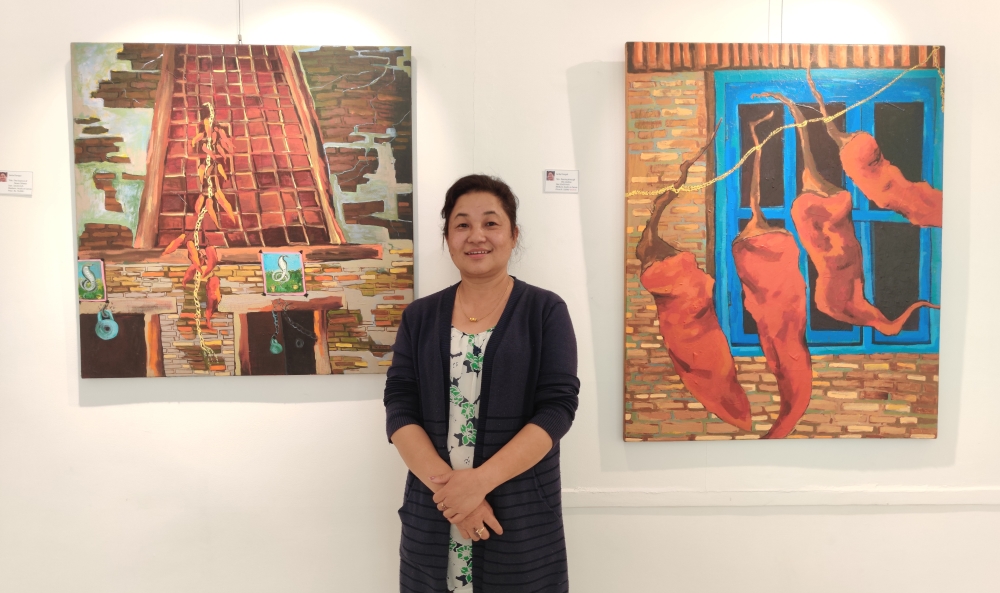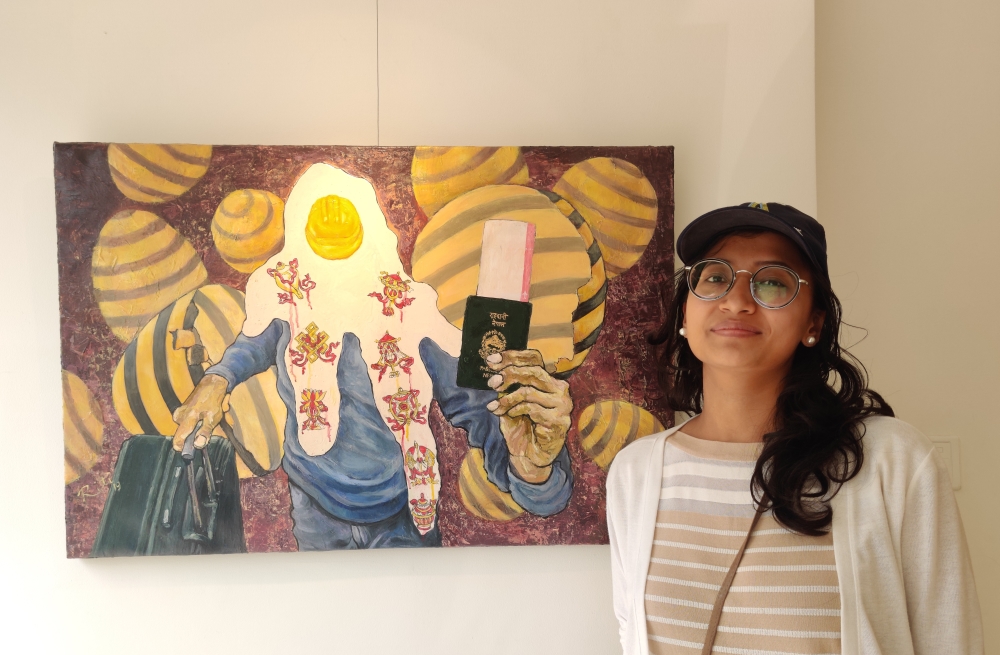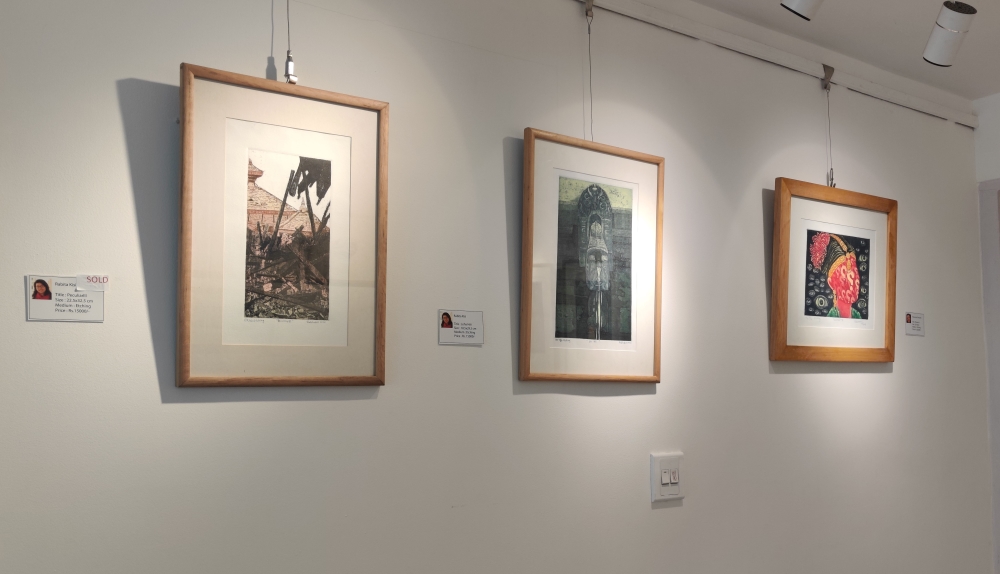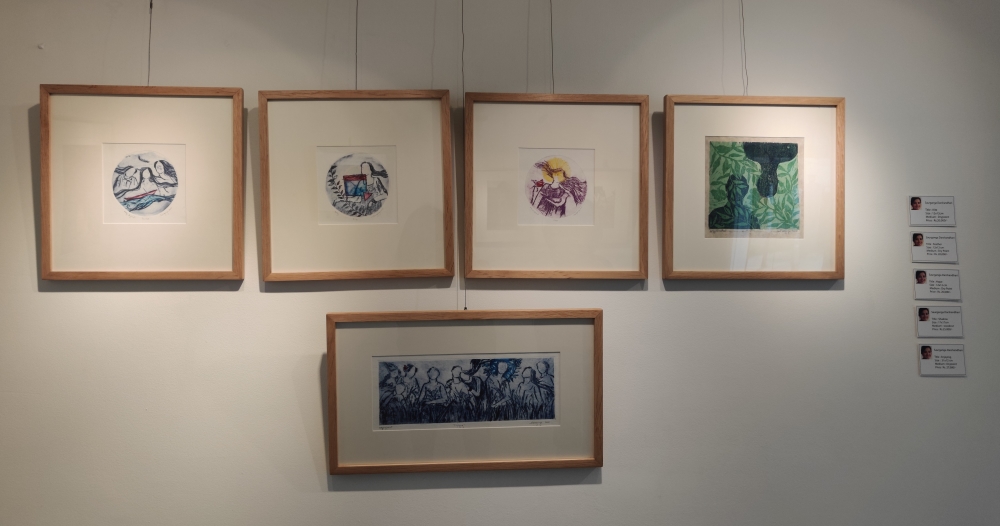Sarita Dongol remembers how her mother insisted on keeping a piece of chilli in her lunchbox throughout her childhood.
“She believed that the food would be protected from any ill intent or negative soul when a chilli is placed inside,” Dongol remembers, “Any occasion when I forgot to put a chilli inside would result in a long lecture and a great deal of anxiety in me.”
In her adult life, Dongol, who has made a career in the field of fine art and visual art today, now started depicting chillies on her canvases that she says is an ode to her childhood experiences. Art lovers from different social backgrounds, including those from different ethnic groups and genders, have appreciated her works about chillies, but sometimes she just feels women artists cannot get a platform to showcase their art and the stakeholders of the art industry have been biased against women artists just because of their gender.

Dongol’s paintings from the ‘Chilli series’ is one of the attractions in the ongoing ‘Reflection of Feminine Power on Art Part II’ at the Classic Gallery of Chakupat in Lalitpur. The exhibition that started on March 18 to commemorate Women’s Month features paintings of other nine women artists on different themes.
Artists like Dangol who participate in the exhibition say such an event dedicated to women artists and their works is crucial as they feel the Nepali art industry is still gendered although art per se is not.
Letting women go beyond ‘women’s issues’
The exhibition aims to empower women by giving them exposure and a platform to be recognised. Nevertheless, the exhibition has not necessarily defined ‘women issues’ as its theme.

According to Dongol, the curator of the exhibition, the organisers kept the theme open to give a message that they do not need to put such themes to empower women. “Art has never been gendered; it does not belong to either sex exclusively,” she says, “Artists have that sacred space–their canvases, nationally and internationally, where they can identify themselves with their art. Internationally, artworks of Nepali women artists have been sought after, and that is our progress.”
“In terms of marketing as well as a number of art genres and outlets, what an artist can use to express themselves has evolved for the better. The artworks featured in the exhibition are an example of how art has become a stronger tool for women to ensure their freedom of expression,” she adds.
Riti Maharjan, a visual artist featured in the exhibition, agrees. “I have never heard the audience say that an art piece is good or bad because of the artist’s gender. And, I believe we will not reach that situation.”
“Rather, how well we are able to communicate with the audience depends on the skill and how we portray our thoughts and ideas.”

Another visual artist and art student Phurwa Lama says, “The art quality does not falter because of one’s gender; they have been equally appreciated because they are good and have emotionally touched the audience.”
Then, why ‘women-only’ exhibition?
Nonetheless, these artists agree that artwork itself can help identify the artist. Lama adds, “The kind of colour, the tone, the texture and its technique used in artworks can help one identify who the artist is, including their gender, although not categorically. When it comes to women’s issues, men can only depict them on the basis of hearsay. Women live problems and can better portray them.”

Accordingly, they say women artists should use their skill to express their concerns about their life and society.
Maharjan views, “Nepal still battles with so many discrepancies that still need to be discussed. Issues like domestic violence, rape, suppression and women empowerment are still relatable to our audience. And, such artworks speak well here rather than anywhere else. So, that helps us reach out to them.”
Dangol adds, “Our society is still struggling to get out of the system we have been brought up with.” She gives the example of her own sector. “Women were degraded, humiliated or simply not supported for studying and pursuing art as a career in the past. The times have changed: they now have stepped out of the house and strongly choose to be empowered through art. Yet, they are still struggling to get the same level of opportunities or exposure to take their art into the world.”
Given it is the month of March, discussions in and around women and women empowerment are common. Maharjan and Dongol both say such changes are not sufficient yet.

Hence, Maharjan thinks such exhibitions are ways for arts and the audience meet each other personally. “These events should occur more, not just in March, for the promotion of art and of women artists who are still struggling for the exposure.”
Dongol argues, “In my 30 years in the field, not much has changed in terms of women artists and the kind of exposure they get. We still feel the need to celebrate Women’s Day, to have separate exhibitions just to promote women artists.”
Hence, the motive of these exhibitions is to give women that exposure, the curator says.
The exhibition will go on till April 20, 2021. And artists hope the exhibition and other similar ones will help create the dialogue that promotes the art sector and artists alike. “I want to see a future where people search for art exhibitions with the same dedication as they give while searching for movies.”




























